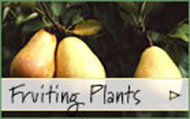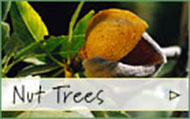NSPLSUG
|
|
 |
| SUGAR PLUM (Prunus domestica) |
| A very sweet and richly flavored prune plum suitable for fresh eating, drying and canning. A self fruitful tree with reddish purple fruit. Sugar Plum is known to be a widely adapted, low chill variety. |
|
|
NSPLGRE
|
|
 |
| GREEN GAGE PLUM (Prunus spp.) |
| Ancient Armenian variety still widely grown due to its outstanding flavor. Medium sized, round greenish yellow fruits that are great for dessert, canning, sauce or preserves. Green Gage Plum is productive & self-fertile. Susceptible to brown rot. Hardy to minus 30° F. |
|
|
NSPLSTA
|
|
 |
| STANLEY PLUM (Prunus domestica) |
| Large blue prune plum with sweet yellow flesh. Late ripening & self fertile. Stanley Plum is the most popular U.S. plum tree variety originating in Geneva, NY. Zone 4-9. Photo courtesy Mark Longstroth (MSUE). |
|
|
NSPLBRO
|
|
 |
| BROOKS PLUM (Prunus domestica) |
| Similar to Italian plum, with blue-skinned, yellow-fleshed freestone fruits, but a little sweeter, larger and earlier ripening by a week. The Brooks Plum is good for fresh eating, canning, and for drying into prunes. |
|
|
NSPLITA
|
|
 |
| ITALIAN PLUM (Prunus domestica) |
| Large purple fruit, yellow flesh, sweet free stone, dries well. Italian plum trees are very productive. Self-fertile. Zone 4-9. |
|
|
NSPLEGG
|
|
 |
| YELLOW EGG PLUM (Prunus domestica) |
| Large oval golden yellow skin and flesh is sweet and juicy, yet fairly firm. Somewhat freestone with very good quality for eating fresh and especially good for jam or canning. Self fruitful, hardy plum trees that are very productive. Yellow Egg Plum is an English variety well known prior to 1676. |
|
|
NSPLBLU
|
|
 |
| BLUE DAMSON PLUM (Prunus insititia) |
| Oval blue plums used exclusively for jam, jellies & sauces. Fruit is small, freestone, tart & produced in great abundance. Blue Damson plum is a late blooming & very dependable plum tree. Originated near Damascus, Syria prior to the 1st century B.C. Self fertile. Zone 4-9. |
|
|
NSPLIMP
|
|
|
|

 Click here to view items for:
Winter / Spring (Jan-June)
Summer (July-Oct)
Fall (Nov-Dec)
Click here to view items for:
Winter / Spring (Jan-June)
Summer (July-Oct)
Fall (Nov-Dec)


 Click here to view items for:
Winter / Spring (Jan-June)
Summer (July-Oct)
Fall (Nov-Dec)
Click here to view items for:
Winter / Spring (Jan-June)
Summer (July-Oct)
Fall (Nov-Dec)















